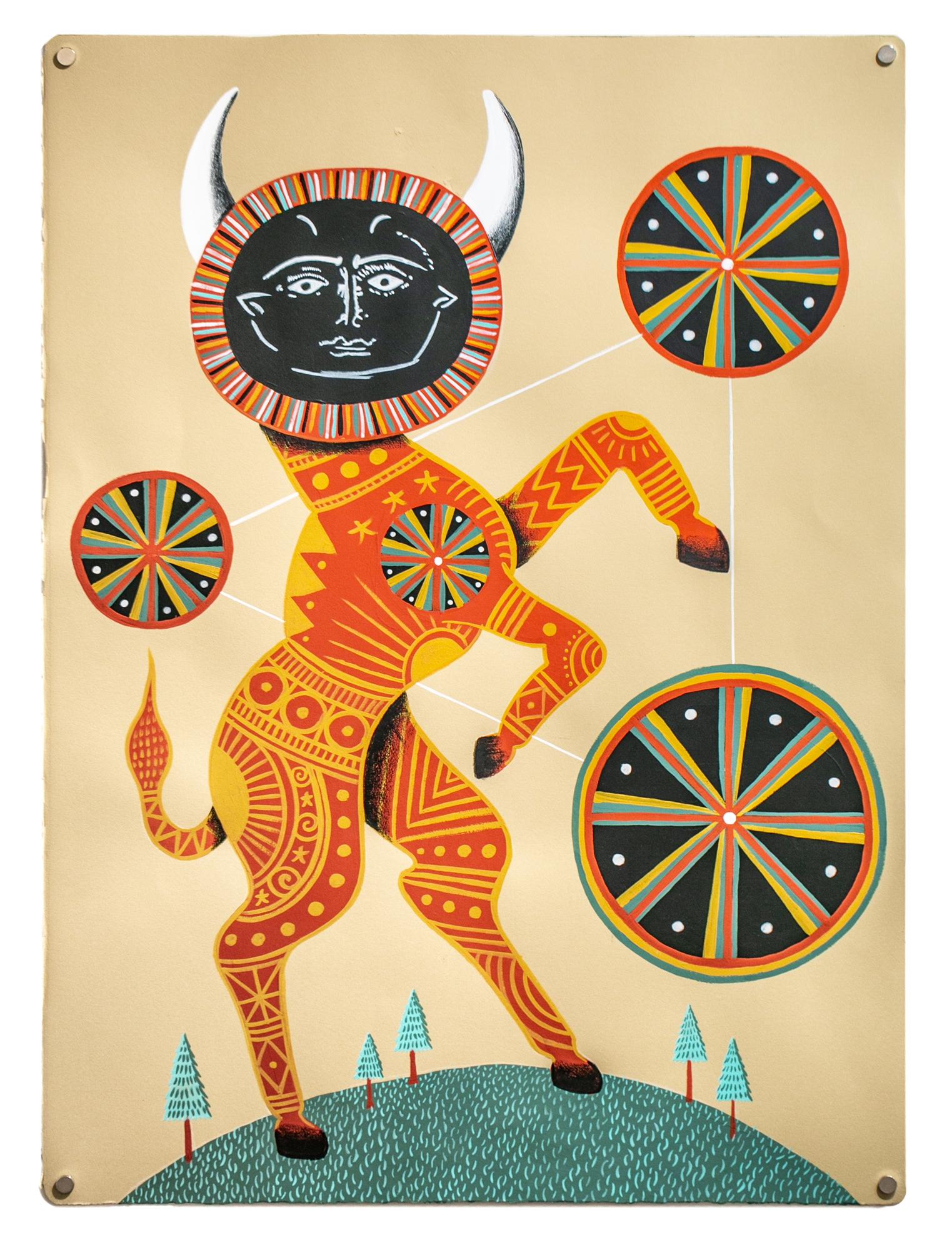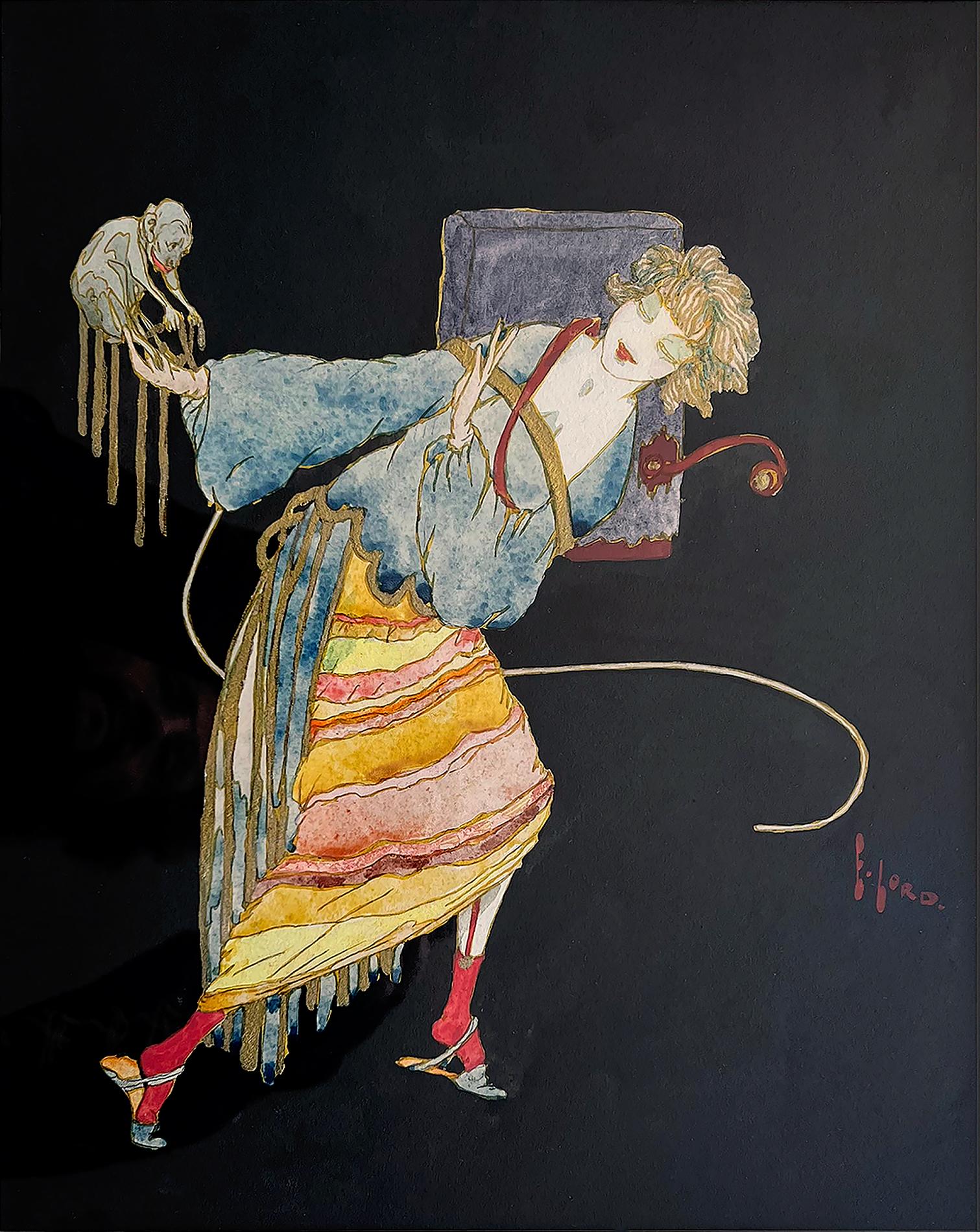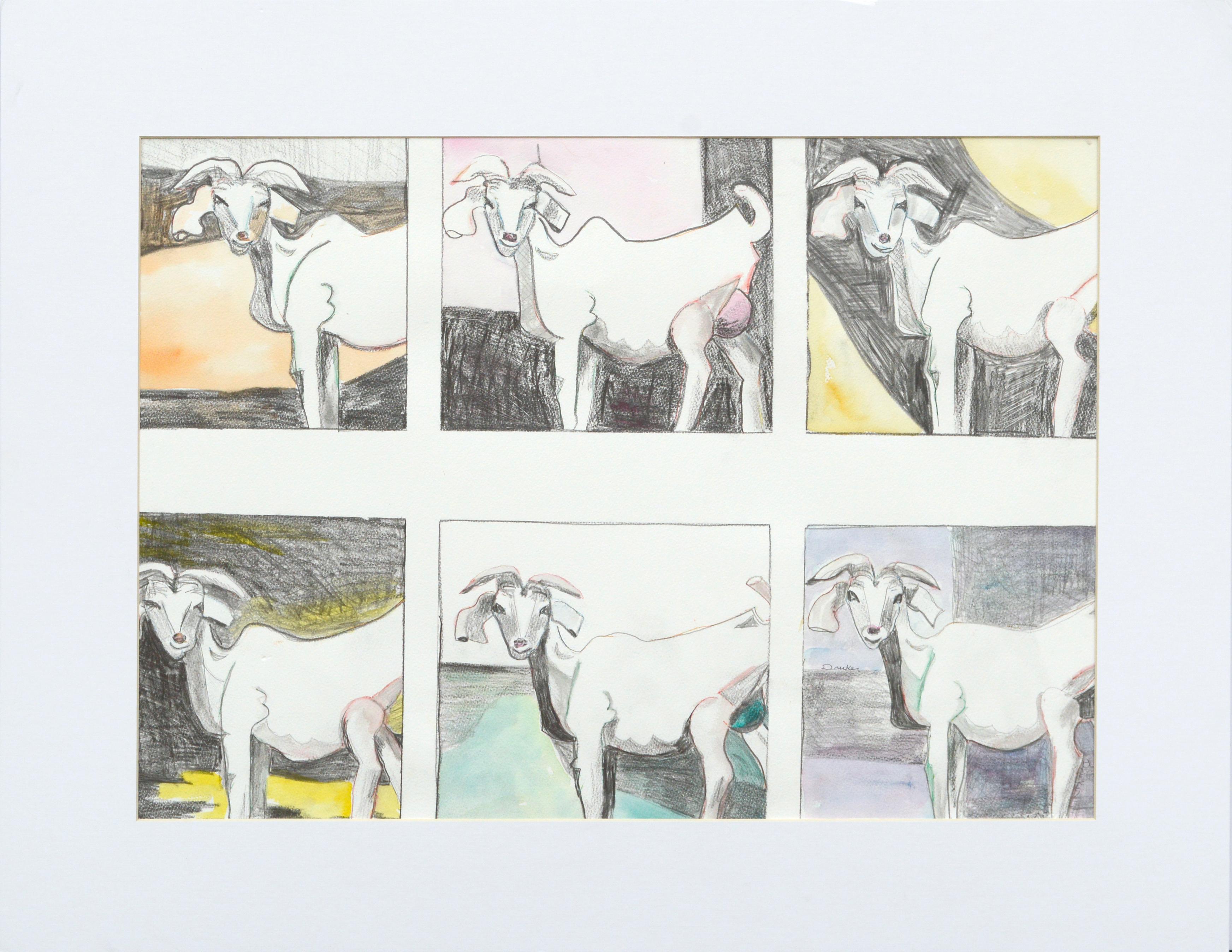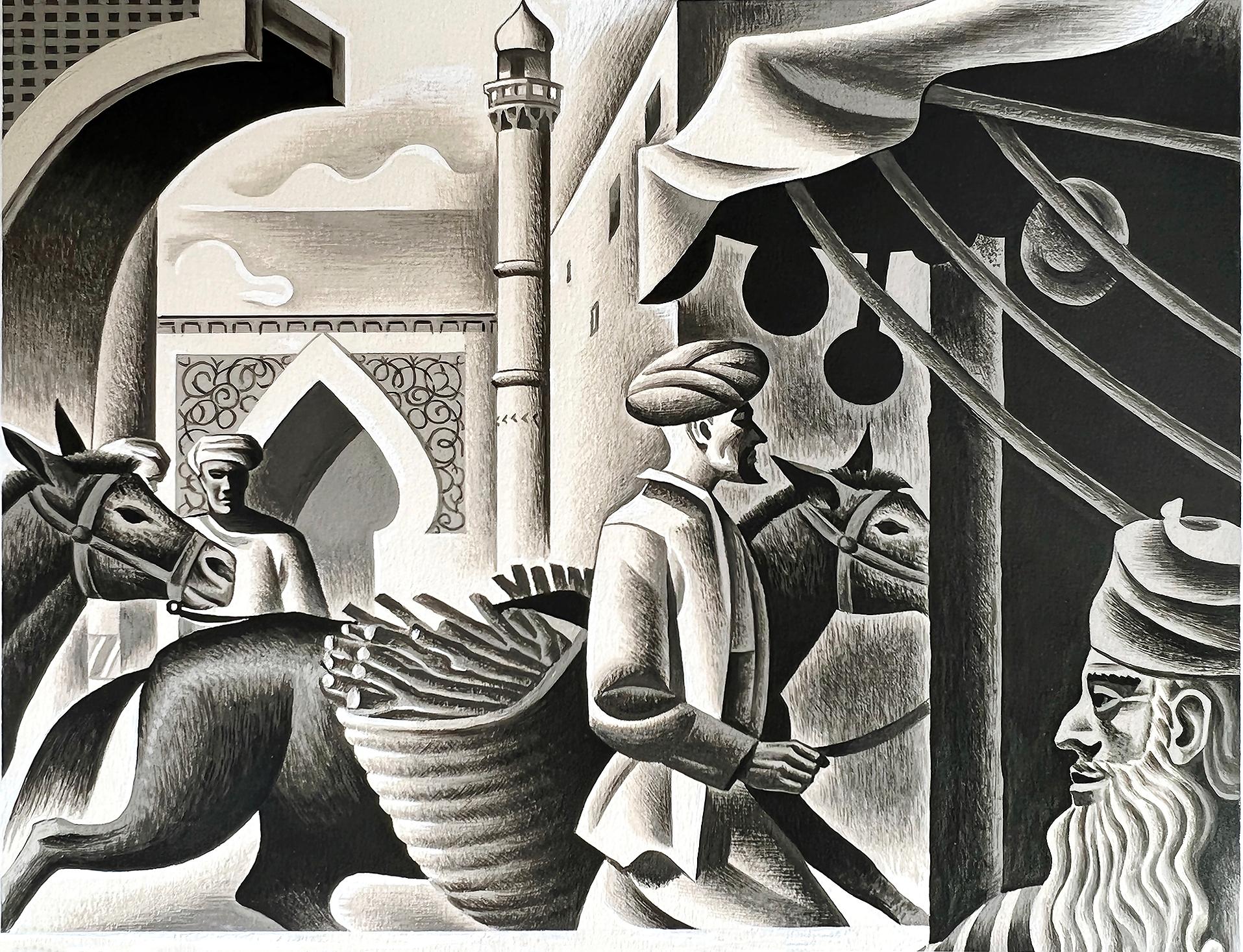Items Similar to Art deco mixed media on paper - Panther in a forest of bamboos by Gaston Suisse
Want more images or videos?
Request additional images or videos from the seller
1 of 8
Gaston SuisseArt deco mixed media on paper - Panther in a forest of bamboos by Gaston Suisse1926
1926
About the Item
Panthère dans les bambous, 1926
Gouache, or et traits de crayon sur papier
Signé et daté en bas à droite
15 x 15 cm (sujet)
Panther in the bamboos, 1926
Gouache, pencil and gold on paper
Signed and dated to the lower right
Provenance
Collection particulière, France - Private collection, France
Bibliographie/Literature :
Emmanuel Bréon "Gaston Suisse, splendeur du laque art déco", Somogy Editions d'art, Paris 2013, oeuvre décrite et reproduite page 104. (l’oeuvre décrite et reproduite est la lithographie tirée d'après l’oeuvre originale que nous présentons.)
Nous présentons ici l'oeuvre originale à la gouache, or et crayon de la panthère noire.
L’artiste en réalisa une gravure sur bois dont il tira lui-même une vingtaine d’épreuve. Ces épreuves ne furent pas commercialisées telles quelles, Gaston Suisse reprit chacune des épreuves en utilisant des lavis d’encre de Chine et des ors de différentes couleurs, afin d’obtenir des effets différents pour chaque épreuve, qui sont donc des œuvres originales uniques.
We present here the original work in gouache, gold and pencil of the black panther.
From this original, the artist made a wood engraving of which he made about twenty prints himself. These proofs were not marketed as they were, Gaston Suisse reworked each of the proofs using Indian ink washes and golds of different colors, in order to obtain different effects for each proof, which are thus unique original works.
Born in 1896 in a family of artists, his father Georges was a close friend of Siegfried Bing and a great lover of Japanese art and a bibliophile. He passed his taste for art to his son whom he often took to draw at the Botanic Garden . Around 1910, Gaston Suisse, who hasn't entered yet the artistic school, met Paul Jouve, then 18 years his elder, who was already famous.
In 1911, at the age of 17, he entered the National School of Decorative Art where he followed the teachings of Paul Renouard. Thanks to his knowledge and taste for the Japanese art, he chose lacquer painting as his specialty. His practice of this noble and demanding subject were so much appreciated that he was awarded with two gold medals in 1913 and 1914. Mobilized during the war , he joined the army and go in Salonika where he found his friend Jouve. In 1918, he finished his studies at the School of Applied Arts in order to perfect his training. He learned in particular the techniques of gilding and oxidation of metals. The first productions of Gaston Suisse, furniture and objects in lacquer with geometrical patterns, were an instant success and Suisse was appointed as member of Salon d'Automne in 1924, the very year of his first exhibition. Considered as an artist-decorator, his sincere and deep friendship with Jouve linked him in parallel with the groups of the animaliers of the Jardin des Plantes and became a close friend of Edouard-Marcel Sandoz. When travelling to Maghreb and Middle-East between 1923 and 1925, he produced numerous drawings representing antelopes, apes and fennec foxes judged of very good quality by his peers from the circle of animaliers. It is under the encouragement of Jouve that he has participated for the first time in the exhibition of animaliers at the Brandt gallery in 1927 where he presented screens, lacquer panels and fireplace screens with decoration of birds whose "brilliance and rhythm" were praised. Suisse treats fishes and birds in the manner of the Far-East masters whose works have nourished his artistic education from childhood while he represents the mammals in a purely Art Deco style by using structured, sometimes even geometric backgrounds whose decorative effect is undeniable. The artist spent most of his time in his atelier and granted only few interviews to the journalists acclaiming however his work. Only his passion for animals made him leave his studio to study them on the field, or at least those that he did not raised at home since he owned birds, snakes, mongooses and other exotic animals. The Museum of 1930s in Boulogne-Billancourt preserves today the immense composition realized for the International Exhibition of Arts et Techniques in 1937, while his creations with animal decorations are scattered all over the world, in the United States and South America in particular. Artist with worldwide success, the Vernon museum organized in 2000 a retrospective exhibition exclusively dedicated to his works devoted to animals.
- Creator:Gaston Suisse (1896 - 1988, French)
- Creation Year:1926
- Dimensions:Height: 6.5 in (16.5 cm)Width: 6.3 in (16 cm)
- Medium:
- Movement & Style:
- Period:
- Condition:A few minor and small scratches on the frame.
- Gallery Location:Carouge GE, CH
- Reference Number:1stDibs: LU2225211392472
About the Seller
5.0
Gold Seller
These expertly vetted sellers are highly rated and consistently exceed customer expectations.
Established in 2016
1stDibs seller since 2022
15 sales on 1stDibs
- ShippingRetrieving quote...Ships From: Carouge GE, Switzerland
- Return PolicyA return for this item may be initiated within 14 days of delivery.
More From This SellerView All
- Art deco handcolored woodcut on paper - Walking black panther by Gaston SuisseLocated in Carouge GE, GEGaston Suisse (1896-1988) Panthère noire dans les bambous, 1927 Gravure sur bois, sur papier Velin de Van Gelder. Rehaussé aux lavis d’encre de Chine par l’artiste Signé en bas à gauche et daté 1927 en bas à droite Black panther in a forest of bamboos, 1927 A handcolored woodcut on Velin de Van Gelder paper Signed and dated 1927 Bibliographie /Literature Gaston Suisse, splendeur du laque art déco. Emmanuel Bréon. Somogy Éditions d'art, Paris 2013, reproduite page 105 (un autre exemplaire reproduit) The artist made a wood engraving of which he made about twenty prints himself. These proofs were not marketed as is, Gaston Suisse reworked each of the proofs using Indian ink washes in order to obtain different effects for each proof, which are thus unique original works. Born in 1896 in a family of artists, his father Georges was a close friend of Siegfried Bing and a great lover of Japanese art and a bibliophile. He passed his taste for art to his son whom he often took to draw at the Botanic Garden . Around 1910, Gaston Suisse, who hasn't entered yet the artistic school, met Paul Jouve, then 18 years his elder, who was already famous. In 1911, at the age of 17, he entered the National School of Decorative Art where he followed the teachings of Paul Renouard. Thanks to his knowledge and taste for the Japanese art, he chose lacquer painting as his specialty. His practice of this noble and demanding subject were so much appreciated that he was awarded with two gold medals in 1913 and 1914. Mobilized during the war , he joined the army and go in Salonika where he found his friend Jouve. In 1918, he finished his studies at the School of Applied Arts in order to perfect his training. He learned in particular the techniques of gilding and oxidation of metals. The first productions of Gaston Suisse, furniture and objects in lacquer with geometrical patterns, were an instant success and Suisse was appointed as member of Salon d'Automne in 1924, the very year of his first exhibition. Considered as an artist-decorator, his sincere and deep friendship with Jouve linked him in parallel with the groups of the animaliers of the Jardin des Plantes and became a close friend of Edouard-Marcel Sandoz. When travelling to Maghreb and Middle-East between 1923 and 1925, he produced numerous drawings representing antelopes, apes and fennec foxes...Category
1920s Art Deco Animal Prints
MaterialsIndia Ink, Woodcut
- Le triomphe de la mort, 2000, oil on canvas by Jean JansemBy Jean JansemLocated in Carouge GE, GEJean Jansem (1920-2013) Le triomphe de la mort, 2000 Huile sur toile Signée en bas à gauche et à droite 150 x 200 cm Bibliographie: Cette oeuvre est enregistrée dans les archives de l’Association des Amis de Jean Jansem. Figurera dans le catalogue critique de l’oeuvre de Jean Jansem actuellement en préparation par l’association des amis de Jean Jansem Historique: L’indigence d’après-guerre et la difficulté inhérente de trouver les matériaux adéquats et/ou habituels, telles les couleurs, très onéreuses alors, ont poussé les artistes figuratifs de l’après-guerre, en corrélation avec les préoccupations de l’époque, à redéfinir les paradigmes de la représentation. Il n’est plus question de chercher un sens mais bien pour les artistes d'étudier l’objet pour son intérêt formel, sa qualité intrinsèque. Le regard de l’artiste devient analytique et dépeint alors l’objet pour ce qu’il est et non plus pour son pouvoir évocateur ou symbolique. La nature morte n’est plus une invitation sensuelle à la ripaille, la pomme ou la pêche n’évoque aucune envie de croquer, la cruche aucune ivresse, la volaille...Category
Late 20th Century Expressionist Figurative Paintings
MaterialsCanvas, Oil
- La salle de répétition de l'opéra de Paris, 1968, oil on canvas by Jean JansemBy Jean JansemLocated in Carouge GE, GEJean Jansem (1920-2013) La salle de répétition de l’Opéra de Paris, 1968 Huile sur toile Signée en bas à gauche 130 x 195 cm Provenance: Wally Findlay Galleries, New York Bibliographie: Cette oeuvre est enregistrée dans les archives de l’Association des Amis de Jean Jansem. Figurera dans le catalogue critique de l’oeuvre de Jean Jansem actuellement en préparation par l’association des amis de Jean Jansem Historique: 1964: c’est l’inauguration du nouveau plafond du Palais Garnier par Marc Chagall commandé par André Malraux alors ministre chargé des affaires culturelles. Commande qui fera couler beaucoup d’encre entre les partisans du modernisme et les tenants du conservatisme. Malraux tiendra bon, si ce n’est une légère concession: pour éviter de détruire l'ancien plafond et son décor, il sera masqué par une toile amovible de quelques 240m2 réalisée par Chagall dans les ateliers des Gobelins puis tendue par-dessus. Cette commande, autant acte politique que intellectuel, intervient à une époque où Malraux, convaincu que l’art contribue au rayonnement international de la France, soutiendra notamment les commandes du Mobilier national dont Pierre Paulin sera l’une des grandes figures, et où la CGT (Compagnie générale transatlantique) lancera un de ses plus gros chantiers avec le mythique paquebot France...Category
Late 20th Century Expressionist Figurative Paintings
MaterialsCanvas, Oil
- La lagune à Venise, 1968-69, oil on paper laid on canvas by Jean JansemBy Jean JansemLocated in Carouge GE, GEJean Jansem (1920-2013) La lagune à Venise, 1968-1969 Huile sur papier marouflée sur toile Signée en bas à droite 50 x 65 cm Bibliographie: Cette oeuvre est enregistrée dans les archives de l’Association des Amis de Jean Jansem. Figurera dans le catalogue critique de l’oeuvre de Jean Jansem actuellement en préparation par l’association des amis de Jean Jansem Historique: L’artiste a longuement séjourné à Venise, notamment à Mazzorbo et la lagune a toujours eu une place bien particulière dans l’oeuvre et le coeur de Jansem. L’artiste y aura réalisé nombre de dessins et une trentaine de toiles seulement, dont chacune, représentation de l’eau et du ciel, est le témoin de l’imprégnation pérenne de la lumière si spécifique de la lagune dans l’oeuvre de l’artiste. Cette œuvre est une bien belle démonstration de cette utilisation magistrale de la lumière. Artiste français d'origine arménienne, né en 1920 en Turquie, Jansem arrive en France...Category
Late 20th Century Expressionist Figurative Paintings
MaterialsCanvas, Laid Paper, Oil
- Le petit soldat, 1993, original lithograph by Jean Jansem handsignedBy Jean JansemLocated in Carouge GE, GEJean Jansem (1920-2013) Le petit soldat, 1993 Lithographie sur papier Arches Signée et justifiée 76 x 50 cm Imprimeur: Arts-Litho, Paris Editeurs: Jansem, Paris - Enrico Navarra B...Category
Late 20th Century Expressionist Figurative Prints
MaterialsLithograph
- Le Tambour, 1984, original lithograph by Jean Jansem, handsigned and numberedBy Jean JansemLocated in Carouge GE, GEJean Jansem (1920-2013) Le tambour, 1984 Lithographie sur papier Arches, justifiée EA Signée en bas à droite 67,5 x 47 cm / 76 x 54 cm Bibliographie: CR Jansem, 1993, n°1 "Ma pre...Category
Late 20th Century Expressionist Figurative Prints
MaterialsLithograph
You May Also Like
- FawnBy Henry HablakLocated in Philadelphia, PA"Fawn" is an original ink, colored pencil, and gouache on paper artwork by Henry Hablak measuring 30"h x 22"w. Henry Hablak is a tattoo artist and illustrator based out of Philadel...Category
2010s Contemporary Animal Drawings and Watercolors
MaterialsPaper, Ink, Gouache, Color Pencil
- Liber Mystia XLIIIBy Henry HablakLocated in Philadelphia, PA"Liber Mystia XLIII" is an original artwork by Henry Hablak made of gouache, ink, and colored pencil on paper measuring 16.25"h x 12.25"w framed and 14"h x 11"w unframed. Henry Habl...Category
2010s Contemporary Figurative Drawings and Watercolors
MaterialsPaper, Ink, Gouache, Color Pencil
- Art Deco Woman Holding Monkey - Female IllustratorBy Elyse Ashe LordLocated in Miami, FLMeticulously rendered art deco illustration of a stylized woman ( perhaps Asian ) having a dialog with a small monkey perch on her outstretched arm. ...Category
1920s Art Deco Figurative Drawings and Watercolors
MaterialsGold Leaf
- LepidopteraBy Shamona StokesLocated in Jersey City, NJWatercolor, flashe, color pencil, ink, silver paint, matte medium and Black 3.0 on watercolor paper, 55" high x 77" wide Vivid matte blue, red, gray, silver and black Framing availa...Category
2010s Contemporary Figurative Drawings and Watercolors
MaterialsPaper, Color Pencil, Ink, Archival Ink, Watercolor, Archival Paper
- Six Goats, Modernist Goat Animal Portrait SeriesBy Karen DrukerLocated in Soquel, CAPlayful portraits of six goats, a series arranged in panels, by Karen Druker (American, 1945). Signed "Druker" in the lower right corner. Presented in an off-white mat. No frame. Ima...Category
21st Century and Contemporary Contemporary Animal Drawings and Watercolors
MaterialsWatercolor, Pencil, Color Pencil, Paper
- Arabian nights The Thousand and One Nights Donkey Scheherazade, IslamBy Gustaf TenggrenLocated in Miami, FLThis is a masterfully rendered and brilliantly designed scene from the Arabian Nights. page 33 from Random House. We are not sure if this is by Gustaf Tenggren. However, there are su...Category
1950s Art Deco Figurative Drawings and Watercolors
MaterialsGouache





